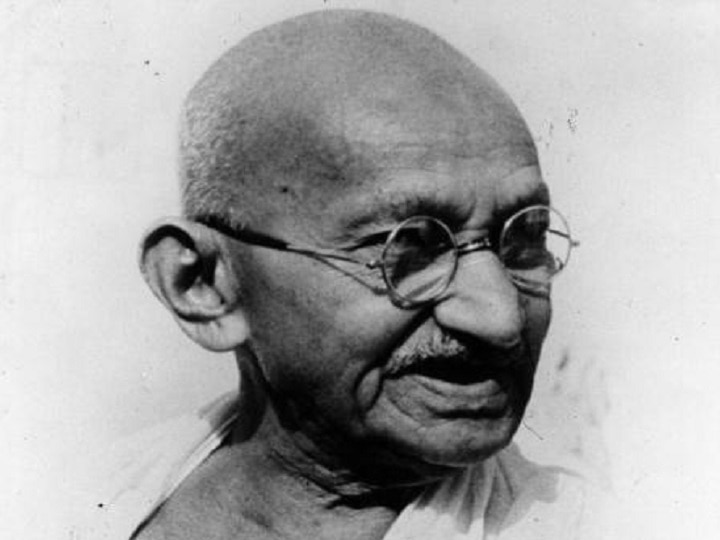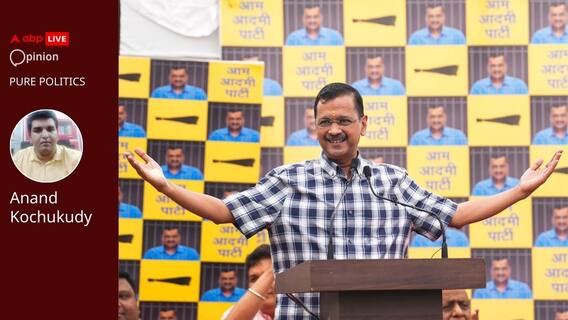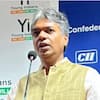Explorer
Advertisement

The Undeveloped Heart: Gandhi On Education
Gandhi Jayanti, has come and gone. Thousands of statues of Gandhi were doubtless garlanded, and I suspect that some new statues were installed. We all know, of course, that Mohandas Gandhi would have sharply disapproved of these celebrations.

4th October 1946: Mahatma Gandhi (Mohandas Karamchand Gandhi, 1869 - 1948). (Photo by Fox Photos/Getty Images)
October 2nd , Gandhi Jayanti, has come and gone. Thousands of statues of Gandhi were doubtless garlanded, and I suspect that some new statues were installed. We all know, of course, that Mohandas Gandhi would have sharply disapproved of these celebrations. He never had much use for statues, having noted that they were perhaps most useful to pigeons. That flowers should be plucked to create garlands which make their way from statues to streets and garbage bins struck him as not merely senseless but as a form of violence. Barely anyone listened to him in his lifetime, certainly not in his last painful years, and fewer still are those who listen to him now.
And then there are the customary homilies to him. No one has to have listened to the Indian Prime Minister’s speeches this October 2nd to know that he would have exhorted the nation and especially school children to follow the example of Bapu. School principals all over the country would have done the same, taking Gandhi as an example of someone who, as they believe, understood the value of education and was himself a product of a well-established educational system. If there is one thing that “reasonable” and “sensible” people agree upon, even if they are not predisposed to a liberal point of view, it is that education is the sine qua non of the progress of individuals, communities, and nations.
Thus it behooves us to consider, howsoever briefly, what Gandhi thought of education. He had, on this subject as much as anything else that occupied his attention, strong, carefully reasoned, and wholly unconventional views. Since nearly everything that he stood for has been consigned to oblivion in modern India, even, let it be clear, his views on “cleanliness”, it is scarcely surprising that his outlook on education has similarly been dismissed by Indians as hopelessly idealistic, old-fashioned, and utterly unworthy of their attention. The Gandhians who have encapsulated his thinking under the term “Nai Taleem”—and it is quite irrelevant that Gandhi himself used the term - have not helped, given that the term is calculated to send middle class Indians into a panic. Middle class Indians know that those who follow “Nai Taleem” will never gain entrance to even a second-rate Indian university, much less St. Stephen’s College, JNU, Ashoka University, or the yet more exalted institutions of higher education in Britain and especially the United States.
The story of Gandhi’s radical skepticism about modern education is best told, in the first instance, through an anecdote from his life in the mid-1930s. An American clergyman by the name of Reverend Mott came to visit him at Sevagram and they engaged in extended conversations over the course of several days. Towards the end of his stay, seeking to crystallize their discussions into a few important insights, Rev. Mott posed two questions.
“Tell me, Mahatmaji”, he asked Gandhi, “what is it that, after nearly two decades of the freedom struggle, still gives you the greatest hope”? Gandhi unhesitatingly replied, “What gives me the greatest hope is that even today most Indians, despite the gravest provocations, still stand by their faith in ahimsa.” Rev. Mott then moved on to the next question: “And what is it that fills you with the greatest fear and makes you exceedingly unhappy”? Gandhi, we are told, paused for a long moment - and then said: “What fills me with the greatest sorrow is the hardheartedness of the educated.”
It is more than likely that today Gandhi would have had reason to question his faith in the adherence of his fellow Indians to ahimsa. But, on the question of education, it is rather remarkable that, at a time when the educated comprised a relatively tiny community, Gandhi already was deeply suspicions about the value and utility of formal education. Some people have thought it hypocritical that, having availed of higher education in London, Gandhi was not inclined to let his two older sons pursue the same course of action. At a time when Gandhi and the Congress were championing swadeshi institutions, he could ill afford to let his own children acquire higher education in England. But Gandhi wasn’t merely trying to look good or be, in contemporary jargon, “politically correct”. It is precisely his own experience with higher education that, in his view, conferred on him the moral authority to repudiate its alleged benefits.
Modern education, as Gandhi understood it, thrives on a number of disjunctions that are absolutely fatal to the development of a person’s moral faculty and thus to the conception of the person as a whole entity. Such formal education, which begins as children start going to school and is amplified over the years, receiving its most pronounced expression in university education, aggravates the divide between the head and the heart, between mind and body, between intellectual work and the work of labor, between reason and emotion, indeed between thought and feeling. “I would develop in the child”, wrote Gandhi in Young India on 12 March 1925, “his hands, his brain and his soul. The hands have almost atrophied. The soul has been altogether ignored.”
He spoke often of how education in India had to be “revolutionized. The brain must be educated through the hand. If I were a poet, I could write poetry on the possibilities of the five fingers” (Harijan, 18 February 1939). Time and again, Gandhi wrote, and wrote insistently, passionately, and from the viewpoint of some whose certitude derives from a lifetime of thought and experience, in this vein. “Now, I wish to say that whatever is taught to children, all of it should be taught necessarily through the medium of a trade or handicraft.” So he said in his address to the Wardha Education Conference on 22 October 1937. But Gandhi anticipates the objections of those who, pointing to its “irrelevance” in the modern world, might scorn at learning a “handicraft”, by arguing that “we aim at developing the intellect also with the aid of such trade or handicraft.” The takli [spindle] shall also be the medium through which students “would be able to learn a substantial part of the history of cotton, Lancashire and the British empire.”
When Gandhi adverted to the hardheartedness of the educated, he also had in mind the view that modern educational systems are not designed to teach compassion or empathy for the poor and the wronged. Education may inspire a well-meaning economist to draw up a model for the alleviation of poverty, but almost nothing in the economist’s education gives him or her a feel for the lives of the poor. If anything, the economist’s model is much more likely to worsen the condition of the poor: entranced by his own artful games, the economist overlooks the fact that most models rarely have any relationship to the reality that they purport to describe. Their referential world is other models, and the work of other economists; and before the well-meaning economist knows it, the lives of the poor themselves get reduced to a series of numbers and abstractions. In all this, the meaning of “poverty” itself never gets interrogated. Perhaps the economist might begin fruitfully with some reflections on the sheer poverty of his discipline.
For all its failings, Gandhi did not give up on education. One keeps on learning to the end of one’s life. He regretted the “hardheartedness” of the educated, not their heartlessness—which is a rather different thing. I very much doubt that Gandhi thought of anyone as ‘heartless’, and he would have agreed with the novelist E. M. Forster that the British had an “undeveloped heart”. Education had hardened the British, too, and in his visit to Britain in 1931 he found that the warmest receptions he received were from the working class, particularly the mill workers of Lancashire who had suffered the most from the boycott of British textile manufactures that Gandhi had initiated in India.
There are many indices one can use to measure the shocking failures of education, even as it is conventionally understood, in India today. The stories of state-run schools that are in absolute shambles are legion, and have been documented by thousands of researchers, journalists, and social workers. More than seventy years after independence, the effective literacy rate is less than 50%; in some districts of Rajasthan, Uttar Pradesh, Jharkhand, and Madhya Pradesh, female literacy rates still hover at 10%. The best public universities have been gutted; all that is left is a shambolic display of awards of “excellence”, a word as shorn of content as any, in one instance to an institute of higher education that does not even exist.
Yet all this is far from what Gandhi had in mind, and I wonder how he would have struggled to even comprehend the “hardheartedness” of the educated in India. Let there be no mistake: what really ails Indian education is the fact that at its center is the “undeveloped heart.”
(Vinay Lal is a writer, blogger, cultural critic, and Professor of History at UCLA)
Disclaimer: The opinions, beliefs and views expressed by the various authors and forum participants on this website are personal and do not reflect the opinions, beliefs and views of ABP News Network Pvt Ltd.
Follow Blog News on ABP Live for more latest stories and trending topics. Watch breaking news and top headlines online on ABP News LIVE TV
View More
Blog
 “ Kejriwal’s Age Ceiling ‘Surgical Strike’ At Modi Has Set A Blaze BJP May Not Be Able To Put Out
“ Kejriwal’s Age Ceiling ‘Surgical Strike’ At Modi Has Set A Blaze BJP May Not Be Able To Put Out

Anand Kochukudy
Advertisement
Advertisement
Advertisement
Advertisement
Trending News

for smartphones
and tablets
and tablets

Sagarneel SinhaSagarneel Sinha
Opinion

























